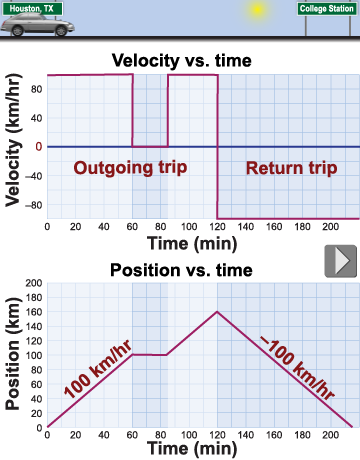|
The velocity versus time (or v vs. t) graph shows velocity on the vertical axis and time on the horizontal axis. This graphical model provides a quick visual history of how the velocity changes. The v vs. t graph can fool you, however, unless you remember that the y-axis is velocity, not position! In particular, a negative portion of a v vs. t graph means traveling in the backward direction. 
| 
|
|
The diagram on the right shows the x vs. t and v vs. t graphs for a round trip between Houston to College Station. The motion is the same in both the graphs, but the way the motion appears on the two graphs is quite different:
|
- Constant speed is a sloped line on the x vs. t graph but a flat line on a v vs. t graph.
- The slope of the x vs. t graph is equal to the value of the v vs. t graph at the same time interval. In this example, during the first hour the slope on the x vs. t graph is 100 km/hr, and this is the value of the v vs. t graph during this hour.
- On v vs. t graphs, zero velocity lies on the x-axis where the y value is 0 km/hr.

|
To find the distance traveled from a velocity versus time graph, we use a graphical interpretation of the equation d = vt. Consider the orange-shaded rectangle on the v vs. t graph below. This rectangle fills the area between the line representing velocity and the x-axis where v = 0. The area of a rectangle is length times height. On the v vs. t graph, length is equal to time and height is equal to velocity. Therefore, area on this graph equals velocity multiplied by time, which is the distance traveled. This is an important result! Area on a v vs. t graph represents distance. 
|

|
We have now learned that there are two important ways that position versus time and velocity versus time graphs are related to each other: - The slope of a position versus time graph is velocity,
- The area under a velocity versus time graph is the total distance traveled.

|
On a position versus time graph, what type of motion does a line segment with a negative linear slope represent? - moving with a constant negative velocity
- slowing down while moving in the negative direction
- slowing down while moving in the positive direction
- moving with a constant positive velocity along the x-axis
 |
The answer is a. A negative linear slope on a position versus time graph indicates that the object is moving with a constant negative velocity. The velocity versus time graph will show a line segment with a negative value and a slope of zero. 
 |

|

